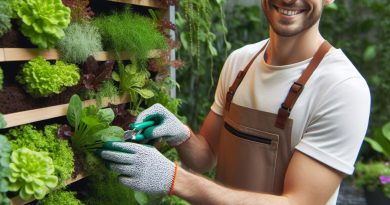Watering Wisdom: How Much is Too Much?
Last Updated on February 8, 2024
Introduction
Plants rely on water to survive and grow, making proper watering a vital aspect of gardening.
However, giving plants too much water can have detrimental effects on their overall health.
Overwatering can lead to root rot, a condition where the roots become waterlogged and start to decay.
Furthermore, excessive watering can suffocate the plant by depriving the roots of oxygen.
Additionally, overwatering can leach essential nutrients from the soil, leading to nutrient deficiencies in the plants.
Finding the right balance is crucial to ensure the well-being of our plants and optimize their growth.
To determine how much water your plants need, it is essential to consider factors such as plant type, weather conditions, and soil type.
Observe your plants closely and check the moisture level in the soil before watering.
Avoid watering on a set schedule and instead water when the plants actually need it.
Allow the top layer of soil to dry out slightly between waterings to prevent overwatering.
Remember, it is always better to underwater than overwater, as most plants can tolerate slight dry spells.
Therefore, adequate watering is important for plant health, but overwatering can have severe consequences.
By finding the right balance and understanding the needs of your plants, you can ensure their optimum growth and wellbeing.
Signs of Overwatering
Knowing the signs of overwatering is crucial for maintaining healthy plants.
Too much water can be just as detrimental as too little, so it’s important to find the right balance.
Here we will discuss each sign in detail:
Wilting plants
One might assume that wilted plants need more water, but often it’s the opposite.
Overwatering suffocates the roots, preventing them from absorbing water and causing the plant to wilt.
Yellowing or drooping leaves
When leaves turn yellow and start to droop, it is an indication that the plant is experiencing stress due to excessive moisture.
Waterlogged roots cannot absorb nutrients properly, leading to yellowing leaves.
Mold or fungus growth
If you notice a fuzzy, white, or greenish substance on the soil or plant, it is likely mold or fungus caused by overwatering.
This growth can inhibit the plant’s ability to take in nutrients and weaken its overall health.
Root rot
Root rot is a serious condition caused by overwatering.
Excess moisture creates a favorable environment for harmful bacteria, leading to the decay and death of the plant’s roots.
Rotting roots cannot absorb water and nutrients effectively.
Waterlogged soil
Overwatered soil becomes compacted and loses its ability to drain excess water.
This saturation impedes oxygen flow to the roots, leading to poor root development and plant suffocation.
Preventing overwatering is essential for maintaining healthy plants.
Here are some tips to avoid this common gardening mistake:
Water smartly
Instead of following a strict watering schedule, check the soil moisture level before watering.
Insert your finger about an inch into the soil; if it feels dry, it’s time to water.
Adequate drainage
Ensure that your plant pots have drainage holes and use well-draining soil to prevent water from accumulating at the roots.
Adjust watering based on climate and plant type
Different plants have different water requirements.
Understand the needs of your plants and adjust watering accordingly.
Consider the humidity and rainfall in your area as well.
Mulch
Apply a layer of organic mulch around your plants to help retain moisture and prevent soil from drying out too quickly.
Use a moisture meter
Investing in a moisture meter can help you accurately gauge when your plants need watering, taking the guesswork out of the equation.
By being aware of the signs of overwatering and following these preventive measures, you can ensure your plants receive the right amount of water, promoting their growth and overall health.
Remember, water wisely and watch your garden thrive!
Read: Organic Pest Control: Tools & Techniques
Determining Watering Needs
Factors affecting water requirements (plant type, size, environment)
Water requirements for plants can vary depending on several factors such as the type of plant, its size, and the environment it is in.
Each plant has different water needs based on its characteristics and the conditions it is exposed to.
For example, some plants, like succulents, have adapted to arid environments and require less water compared to plants that thrive in tropical climates.
Similarly, smaller plants will generally need less water compared to larger ones, as they have a smaller root system and overall water capacity.
Moreover, environmental factors such as temperature, humidity, and light also play a crucial role in determining watering needs.
Plants in hot and dry conditions will typically require more frequent watering to compensate for the increased evaporation and transpiration rates.
Understanding the signs of water stress
Water stress occurs when plants do not receive enough water to fulfill their physiological needs, resulting in negative effects on their growth and overall health.
Recognizing the signs of water stress is vital in providing timely watering to prevent damage.
Some common signs of water stress include wilting leaves, yellowing or browning of foliage, stunted growth, and leaf drop.
Additionally, dry or cracked soil around the plant’s base can be an indicator of insufficient water supply.
Using a moisture meter or test to measure soil moisture
To accurately determine if a plant needs watering, it is advisable to use a moisture meter or perform a soil moisture test.
These tools help gauge the level of moisture present in the soil, allowing for more precise watering decisions.
A moisture meter is a simple device that measures the moisture content in the soil.
By inserting the probe into the soil at different depths, gardeners can determine the moisture level.
This information guides them in deciding whether the plant requires watering or if the soil is still adequately moist.
An alternative to a moisture meter is a soil moisture test.
This test involves manually checking the soil’s moisture by feeling it with your fingers. If the soil feels dry to touch, it is an indication that watering is needed.
Adjusting the watering frequency and amounts accordingly
Once you have determined the watering needs of your plants, it is crucial to adjust the frequency and amounts of watering accordingly.
This ensures that the plants receive the necessary moisture without risking overwatering.
If the soil moisture test or moisture meter indicates dryness, water the plant thoroughly, allowing the water to penetrate to the plant’s roots.
However, it is important not to overwater, as this can lead to root rot and other water-related issues.
On the other hand, if the soil is consistently moist or wet, reduce the frequency of watering to avoid waterlogging the roots.
Overwatering can suffocate the plant’s root system and make it more susceptible to diseases or fungal infections.
Regularly monitoring the plants’ response to watering adjustments and being attentive to their individual needs will help maintain optimal soil moisture levels and promote healthy growth.
Read: Vertical Farming: Maximize Your Garden Space

Watering Best Practices
Watering deeply and less frequently
Watering deeply and less frequently is a fundamental practice when it comes to maintaining a healthy garden.
Rather than giving your plants small amounts of water frequently, it’s essential to provide them with a deep soaking.
This encourages the growth of drought-tolerant roots that can access water from deeper in the soil, making the plants more resilient during dry periods.
Paying attention to plant needs and weather conditions
Paying attention to the needs of your plants and the prevailing weather conditions is crucial to prevent over or under watering.
Different plants have different water requirements, so it’s essential to understand the specific needs of each type of plant in your garden.
Monitoring weather conditions, such as rainfall or drought, allows you to make necessary adjustments to your watering schedule.
Avoiding overhead watering to prevent foliar diseases
Another best practice is to avoid overhead watering whenever possible.
Watering plants at their base instead of from above helps prevent the spread of foliar diseases.
Moist foliage provides an ideal environment for fungal and bacterial pathogens to thrive, leading to various diseases.
By watering at the base, you reduce the chances of these diseases taking hold, ensuring your plants stay healthy.
Mulching to retain moisture
Mulching is an effective technique to retain moisture in the soil.
Organic mulch, such as wood chips or shredded leaves, creates a protective barrier that helps reduce evaporation, keeping the soil moist for longer periods.
Additionally, mulch acts as a natural weed suppressor, reducing water competition and allowing your plants to access more of the available moisture.
Adjusting watering during different seasons
Lastly, adjusting your watering practices based on the changing seasons is essential.
During hot summer months, plants tend to require more water due to increased evaporation.
On the other hand, during cooler seasons or when rainfall is abundant, you can reduce the frequency of watering.
Being mindful of these seasonal variations ensures your plants receive the appropriate amount of water throughout the year.
Basically, adopting these best practices for watering can go a long way in maintaining a healthy garden.
Water deeply and less frequently, pay attention to plant needs and weather conditions, avoid overhead watering, mulch to retain moisture, and adjust your watering habits according to the seasons.
By following these guidelines, you’ll be providing your plants with optimal conditions for growth while conserving water and preventing unnecessary water-related issues.
Happy gardening!
Read: Pest Control: Organic Solutions That Work
Tips for Correcting Overwatering Issues
Improving drainage in soil
- Add organic matter like compost to enhance soil structure and increase drainage capability.
- Use raised beds or containers with drainage holes to prevent waterlogging.
- Avoid heavy clay soils by amending with sand or perlite.
Allowing plants to dry out before watering again
- Check soil moisture by sticking a finger or moisture meter into the soil about 2 inches deep.
- Water only when the top inch of soil is dry to the touch.
- Adjust watering frequency based on weather conditions and specific plant needs.
Trim or remove affected parts of plants
- Inspect plants for symptoms of overwatering like yellowing leaves or root rot.
- Prune away yellow or wilting foliage and remove any rotten or mushy roots.
- Dispose of infected plant material properly to prevent the spread of diseases.
Adjusting watering schedule and amounts gradually
- Gradually extend the time between watering sessions to allow plants to adjust.
- Reduce the amount of water given during each watering, aiming for deep but infrequent watering.
- Monitor plant response and make further adjustments as necessary.
By implementing the tips mentioned above, you can effectively correct overwatering issues and ensure the optimal growth of your plants.
Remember, providing the right amount of water is crucial for maintaining healthy and thriving plants.
Read: Raised Bed Gardening: Tools & Tips
Conclusion
Understanding proper watering techniques is crucial for maintaining healthy plants and maximizing their growth potential.
Finding the balance between overwatering and underwatering is essential:
- Monitor soil moisture regularly.
- Adjust watering frequency based on plant needs.
- Consider environmental factors like temperature and humidity.
Share your watering experiences and tips:
- Discuss strategies for different plant varieties.
- Exchange insights on recognizing signs of overwatering and underwatering.
- Collaborate to create a thriving garden community.
Together, let’s empower each other with knowledge and expertise to achieve watering wisdom in our gardens.


